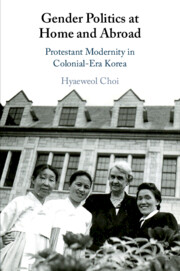Book contents
- Gender Politics at Home and Abroad
- Gender Politics at Home and Abroad
- Copyright page
- Contents
- Illustrations
- Notes on Romanization and Translations
- Preface and Acknowledgments
- Introduction
- 1 Ideology: “Wise Mother, Good Wife”
- 2 Materiality: The Experience of Modern House and Home
- 3 Crossing: Selfhood, Nation, and the World
- 4 Labor: Searching for Rural Modernity
- Conclusion
- Bibliography
- Index
Introduction
Published online by Cambridge University Press: 20 July 2020
- Gender Politics at Home and Abroad
- Gender Politics at Home and Abroad
- Copyright page
- Contents
- Illustrations
- Notes on Romanization and Translations
- Preface and Acknowledgments
- Introduction
- 1 Ideology: “Wise Mother, Good Wife”
- 2 Materiality: The Experience of Modern House and Home
- 3 Crossing: Selfhood, Nation, and the World
- 4 Labor: Searching for Rural Modernity
- Conclusion
- Bibliography
- Index
Summary
The introductory chapter lays out the specific historical context of the period from the late-nineteenth century to the eve of the Asia Pacific War when the competing forces of Japanese colonial power, Korean nationalism, and Western modernities fashioned changes in gender ideology, enabled transnational mobility, and fostered women’s engagement in sociopolitical and economic affairs. The concept of “Protestant modernity” is introduced as a heuristic device to unpack the complex dynamics that shaped gendered modernity in Korea under Japanese colonial rule. Placing gender and religion at the center of the analysis, the chapter diverges from the conventional understanding of modernity as “secularization” and provides a theoretical basis for the argument that the development of modern gender relations finds its roots in the transnational experience of Koreans rather than in the simple nexus of the colonizer and the colonized.
Keywords
- Type
- Chapter
- Information
- Gender Politics at Home and AbroadProtestant Modernity in Colonial-Era Korea, pp. 1 - 35Publisher: Cambridge University PressPrint publication year: 2020

